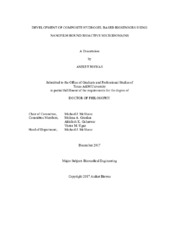| dc.description.abstract | Composite materials have recently been introduced as versatile systems for embedding functional microdomains within moldable hydrogels. Potential applications for these materials include optical biosensing, drug delivery, and anti-corrosion agent releasing smart coatings, wherein the microdomains comprise regions that contain active molecules bound by nanofilms that possess precisely-tailored transport properties.
In this work, composite hydrogels are investigated as sensing materials, with a focus on controlling analyte permeation into the internal microdomains. Transport of glucose across cross-linked PAH [poly (allylamine hydrochloride)] / PSS [poly (sodium 4-styrenesulfonate)] bilayers deposited on planar substrates was studied to evaluate the potential of ultrathin films to limit small-molecule diffusion. The nanofilm design was translated onto calcium carbonate colloidal templates to fabricate hydrogels that contain functional microdomains in order to demonstrate a “tunable” enzymatic biosensor. By varying the number of cross-linked and non-cross-linked bilayers deposited, the response characteristics of the hydrogel based sensors were successfully modulated; however, these sensors exhibited poor stability, prohibiting long term use.
Alginate microparticles containing either glucose sensing or lactate sensing chemistry coated with similar nanofilms were explored as an alternative colloidal template. Response of both glucose and lactate sensing hydrogels fabricated using alginate microparticles was evaluated at ambient oxygen levels and physiologically relevant low oxygen concentrations; this work demonstrated the operation of hydrogel based enzymatic sensors at in vivo oxygen levels for the first time. Additionally, these sensors showed exceptional stability when used continuously, supporting their potential as long term implantable sensors. Furthermore, cooperative effect between biosensing micro- and macro- domains was carefully examined to study the limits of hydrogel based sensors for multiplexed and multianalyte sensing. Additionally, novel gold nanocluster containing microcapsules were explored as hydrogen peroxide sensors for potential coimmobilization in composite hydrogel based enzymatic sensors to monitor levels of hydrogen peroxide release over time; hydrogen peroxide is a byproduct produced in enzymatic glucose and lactate sensors that causes sensor failure.
The results demonstrate significant advances in the field of fully implantable composite hydrogel based devices; especially methods to control the permeation of analytes into bioactive microdomains in order to obtain stable sensor response at physiologically low oxygen levels. The knowledge gained from this study will serve as a guide to fine-tune and optimize composite biosensing hydrogels, after gaining additional information post-implantation in animal models. | en |


